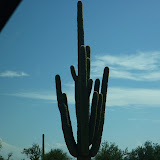
We were on the Apache Trail today. Click on the cactus image above to view the whole album of pictures!
Old Apache Trail Tour - Superstition Wilderness by Tom Kollenborn
The Apache Trail's famous Circle Route begins and ends in Apache Junction, Arizona. This 120 mile scenic route is America's oldest roadway and Arizona’s first Historic Highway. The Apache Trail received that honor on February 25th, 1987. In fact, the Apache Trail has the distinction of being the only recognized Historic and Scenic Highway in Arizona.

The State of Arizona, under the leadership of Governor George P. Hunt in 1919, decided to build a transportation link between Phoenix and the cities of Globe and Miami. Governor Hunt wanted to open the Globe and Miami copper industry to the Phoenix market. The only road in 1919 linking these two important economic centers was the Mesa-Roosevelt Road (Apache Trail) or the long rail route through Tucson, Bowie and Safford.

In 1919, there were several stations along the Apache Trail that serviced the tourist making the long journey by way of motorcar. There was Government Well, Mormon Flat, Tortilla Flat, Fish Creek Lodge and Snell's Station between Mesa and Roosevelt Dam. The completion of the Phoenix-Globe Highway through Superior in May of 1922 completed the famous Circle Route that allowed drivers of automobiles to circumnavigate the entire Superstition Wilderness Area, an almost road-less region.
From http://www.apachetrail.net/
Goldfield Ghost Town (Youngsberg, Arizona) by: Kathy Weiser
Situated atop a small hill between the Superstition Mountains and the Goldfield Mountains on the Apache Trail, the settlement of Goldfield got its start in 1892 when very rich, high grade gold ore was found in the area. A town soon sprang up and on October 7, 1893 it received its first official post office.
This “official” find, coupled with the legend of the Lost Dutchman Mine, which had been circulating for years, led plenty of new miners to the area and in no time, the town boasted three saloons, a boarding house, a general store, brewery, blacksmith shop, butcher shop, and a school. For five years the town boomed until some 1,500 souls were residing in the burgeoning city.
But like other gold camps, Goldfield’s bustling days were quickly dashed when the vein of gold ore started to play out and the grade of the ore dropped even more. Just five years after it began, the town found itself quickly dying. The miners moved on, the post office was discontinued on November 2, 1898, and Goldfield became a ghost town.
However, some prospectors clung on to the area, sure to find the elusive Lost Dutchman Mine or perhaps, a brand new vein. Others tried to reopen the existing mines, but all attempts were unsuccessful until a man named George Young, who was the secretary of Arizona and the acting governor, arrived on the scene in the first decade of the 20th century. Young brought in new mining methods and equipment to recover the ore and the town began slowly come alive once more. Also built was a mill and a cyanide plant. A second post office was established on June 8, 1921 and the “new” town was called Youngsberg. However, the town’s “rebirth” would last only about as long as it did the first – just five years. Finally, the gold was gone, the post office was discontinued on October 30, 1926, and the town died once again.
But Goldfield was obviously not destined to die permanently. In 1966, Robert F. “Bob” Schoose, a long time ghost town, mining, and treasure-hunting enthusiast made his first trip to the Superstition Mountains and instantly fell in love with the area. He moved to Mesa, Arizona in 1970 and soon began to dream of owning his own ghost town. He had heard of the old site of Goldfield, but upon inspection, he found little left other than a few foundations and rambling shacks. He and his wife, Lou Ann, then located another five-acre site that was once the location of the Goldfield Mill and decided with to rebuild the old town. Purchasing the old mill site in 1984, they first reconstructed a mining tunnel, which included a snack bar and opened for business in 1988. Next came a photo shop, the Blue Nugget, a General Store, the Mammoth Saloon and the Goldfield Museum.


No comments:
Post a Comment